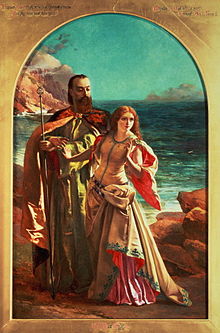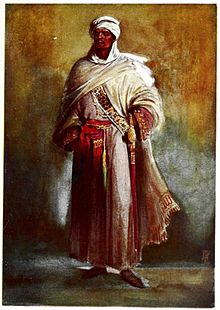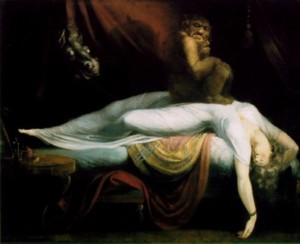Drama 1: Reading, Responding, Writing
Drama 2: Understanding the Text
William Shakespear's "A Midsummer Night's Dream"
The tempest: a play by William Shakespeare, believed to have been written in 1610–11, and thought by many critics to be the last play that Shakespeare wrote alone. It is set on a remote island, where Prospero, the rightful Duke of Milan, plots to restore his daughter Miranda to her rightful place using illusion and skilful manipulation. He conjures up a storm, the eponymous tempest, to lure his usurping brother Antonio and the complicit King Alonso of Naples to the island. There, his machinations bring about the revelation of Antonio's lowly nature, the redemption of the King, and the marriage of Miranda to Alonso's son, Ferdinand.

The shipwreck in Act I, Scene 1
Prospero: a fictional character and the protagonist of William Shakespeare's play The Tempest. Prospero is the rightful Duke of Milan, who (with his then three-year old daughter, Miranda) was put to sea on "a rotten carcass of a butt [boat]" to die by his usurping brother, Antonio, twelve years before the play begins. Prospero and Miranda survived, and found exile on a small island. He has learned sorcery from books, and uses it while on the island to protect Miranda and control the other characters.

Prospero and Miranda
Macbeth: a tragedy written by William Shakespeare, and is considered one of his darkest and most powerful works. Set in Scotland, the play illustrates the damaging physical and psychological effects of political ambition on those who seek power for its own sake. The play is believed to have been written between 1599 and 1606, and is most commonly dated 1606. The earliest account of a performance of what was probably Shakespeare's play is the Summer of 1606, when Simon Forman recorded seeing such a play at the Globe Theatre. It was first published in the Folio of 1623, possibly from a prompt book. It was most likely written during the reign of James I, who had been James VI of Scotland before he succeeded to the English throne in 1603. James was a patron of Shakespeare's acting company, and of all the plays Shakespeare wrote during James's reign, Macbeth most clearly reflects the playwright's relationship with the sovereign.

Othello: a tragedy by William Shakespeare, believed to have been written in the year approximately 1603, and based on the short story Un Capitano Moro ("A Moorish Captain") by Cinthio, a disciple of Boccaccio, first published in 1565. This tightly constructed work revolves around four central characters: Othello, a Moorish general in the Venetian army; his beloved wife, Desdemona; his loyal lieutenant, Cassio; and his trusted but unfaithful ensign, Iago. Because of its varied and current themes of racism, love, jealousy, betrayal, revenge and repentance, Othello is still often performed in professional and community theatre alike and has been the basis for numerous operatic, film, and literary adaptations.

Othello
Iago(阿拉丁裡的鸚鵡)取自Othello的Iago
Iago
Hamlet (the prince of Damark): a tragedy written by William Shakespeare at an uncertain date between 1599 and 1602. Set in the Kingdom of Denmark, the play dramatises the revenge Prince Hamlet is instructed to enact on his uncle Claudius. Claudius had murdered his own brother, Hamlet's father King Hamlet, and subsequently seized the throne, marrying his deceased brother's widow, Hamlet's mother Gertrude. Hamlet is Shakespeare's longest play and among the most powerful and influential tragedies in English literature, with a story capable of "seemingly endless retelling and adaptation by others."[1] The play seems to have been one of Shakespeare's most popular works during his lifetime.


Ophelia
sound and sense
end rhyme: a rhyme that occurs in the last syllables of verses in poetry.
rhyme scheme: the pattern of rhymes at the end of each line of a poem or song. It is usually referred to by using letters to indicate which lines rhyme; lines designated with the same letter all rhyme with each other.
Bid me to weep, and I will weep ABAB
While I have eyes to see;
And having none, yet I will keep
A heart to weep for thee.
visual rhyme (eye rhyme): a rhyme in which two words are spelled similarly but pronounced differently and have come into general use through "poetic license" also known as artistic license. An example is the pair slaughter and laughter; although they look similar, and should rhyme based on the visual aspect, when they are spoken there is no rhyming quality.
Iambic pentameter: a commonly used type of metrical line in traditional English poetry and verse drama. The term describes the rhythm that the words establish in that line, which is measured in small groups of syllables called "feet". The word "iambic" refers to the type of foot that is used, known as the iamb, which in English is an unstressed syllable followed by a stressed syllable. The word "pentameter" indicates that a line has five of these "feet".
Auld Lang Syne: a Scots poem written by Robert Burns in 1788 and set to the tune of a traditional folk song. It is well known in many countries, especially in the English-speaking world, its traditional use being to bid farewell to the old year at the stroke of midnight. By extension, it is also sung at funerals, graduations and as a farewell or ending to other occasions. The international Boy Scout youth movement, in many countries, uses it as a close to jamborees and other functions.
Robert Burns: a Scottish poet and lyricist. He is widely regarded as the national poet of Scotland and is celebrated worldwide. He is the best known of the poets who have written in the Scots language, although much of his writing is also in English and a light Scots dialect, accessible to an audience beyond Scotland. He also wrote in standard English, and in these writings his political or civil commentary is often at its bluntest.
★ Robert Burns使用蘇格蘭方言創作
For example: luve (love)

Robert Burns
"sands o' life" in "A Red, Red Rose" →simile
simile 明喻↔metaphor 隱喻
A Red, Red Rose: a 1794 song in Scots by Robert Burns based on traditional sources. The song is also referred to by the title "Oh, My Love is Like a Red, Red Rose" and is often published as a poem.
To Helen : the first of two poems to carry that name written by Edgar Allan Poe. The 15-line poem was written in honor of Jane Stanard, the mother of a childhood friend. It was first published in 1831 collection Poems of Edgar A. Poe. It was then reprinted in 1836 in the Southern Literary Messenger.
love potion 愛情魔藥
Eros (Cupid)箭法不準→Error
Cupid and Psyche → butterfly 的出現(蝴蝶代表精神抽離)

Cupid and Psyche
Death (Thanatos)and Sleep (Hypnos)
Thanatos was the daemon personification of death. He was a minor figure in Greek mythology, often referred to, but rarely appearing in person.
Hypnos was the personification of sleep; the Roman equivalent was known as Somnus.
Hypnos→Hypnogenesis 催眠
* "Dæmon" is the Latinized versions of the Greek "δαίμων" ("godlike power, fate, god"). It is a word used to refer to the daemons of ancient Greek religion and mythology, as well as later Hellenistic religion and philosophy.

Sleep and His Half Brother Death
L'Amant (The Lover) : an autobiographical novel by Marguerite Duras, published in 1984 by Les Éditions de Minuit. It has been translated to 43 languages and was awarded the 1984 Prix Goncourt. It was adapted to film in 1992 as The Lover.
ant-: 對立 ; 反對 ( ant 字根從古法文演變而來)

quartet 四重奏
英國喜歡用君王的名字為戲劇命名
For example: Elizabethan theatre, Jacobean theatre
→Jacobean refers to James VI and I
English Renaissance theatre: also known as early modern English theatre, or (commonly) as Elizabethan theatre, refers to the theatre of England between 1562 and 1642. This is the style of the plays of William Shakespeare, Christopher Marlowe and Ben Jonson. The phrase Elizabethan theatre is used at times improperly, especially in languages other than English[citation needed], to mean English Renaissance theatre, even though in a strict sense this only applies to 1603. Strictly speaking one distinguishes within English Renaissance theatre between Elizabethan theatre from 1562 to 1603, Jacobean theatre from 1603 to 1625 and Caroline theatre from 1625 to 1642.
Don't get into mischief 別調皮
mis-: 負面的
For example: mistake
wooing n.
woo v.
onomatopoeia 擬聲詞
onomatopoeia is a word that phonetically imitates, resembles or suggests the source of the sound that it describes. Onomatopoeia refers to the property of such words. Common occurrences of onomatopoeias include animal noises such as "oink", "miaow" (or "meow"), "roar" or "chirp". Onomatopoeias are not the same across all languages; they conform to some extent to the broader linguistic system they are part of; hence the sound of a clock may be tick tock in English, dī dā in Mandarin, or katchin katchin in Japanese, or "tik-tik" (टिक-टिक) in Hindi.
amendment 憲法增修條文
apprehend
comprehend
clever 伶俐的, cunning 狡猾的;精巧的, smart


 留言列表
留言列表